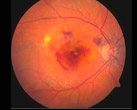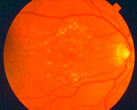| |
 |
|
 |
ARMD or Age Related Macular Degeneration is the leading cause of new cases of blindness in patients over 60 years of age. |
 |
 |
 |
What is age-related macular degeneration? |
Age-related macular degeneration (AMD) is a disease associated with aging that gradually destroys sharp, central vision. Central vision is needed for seeing objects clearly and for common daily tasks such as reading and driving.
AMD affects the macula, the part of the eye that allows you to see fine detail. AMD causes no pain.
|
|
|
 |
In some cases, AMD advances so slowly that people notice little change in their vision. In others, the disease progresses faster and may lead to a loss of vision in both eyes. AMD occurs in two forms: wet and dry. |
 |
| Where is the macula? |
 |
 |
| Human Retina |
|
 |
The macula and it’s centre the fovea is located in the center of the retina, the light-sensitive tissue at the back of the eye. The retina instantly converts light, or an image, into electrical impulses. The retina then sends these impulses, or nerve signals, to the brain.
|
|
 |
What is wet AMD? |
 |
 |
| Wet AMD |
|
 |
Wet AMD occurs when abnormal blood vessels behind the retina start to grow under the macula. These new blood vessels tend to be very fragile and often leak blood and fluid. The blood and fluid raise the macula from its normal place at the back of the eye. Damage to the macula occurs rapidly.
With wet AMD, loss of central vision can occur quickly. Wet AMD is also known as advanced AMD. It does not have stages like dry AMD.
|
|
 |
An early symptom of wet AMD is that straight lines appear wavy. If you notice this condition or other changes to your vision, contact your eye care professional at once. You need a comprehensive dilated eye exam.
|
 |
| What is dry AMD?
|
 |
 |
| Dry AMD |
|
 |
Dry AMD occurs when the light-sensitive cells in the macula slowly break down, gradually blurring central vision in the affected eye. As dry AMD gets worse, you may see a blurred spot in the center of your vision. Over time, as less of the macula functions, central vision is gradually lost in the affected eye.
The most common symptom of dry AMD is slightly blurred vision. You may have difficulty recognizing faces.You may need more light for reading and other tasks.
|
|
 |
Dry AMD generally affects both eyes, but vision can be lost in one eye while the other eye seems unaffected.
One of the most common early signs of dry AMD is drusen. |
 |
| Causes and Risk Factors |
 |
Who is at risk for AMD? |
 |
| The greatest risk factor is age. Although AMD may occur during middle age, studies show that people over age 60 are clearly at greater risk than other age groups. For instance, a large study found that people in middle-age have about a 2 percent risk of getting AMD, but this risk increased to nearly 30 percent in those over age 75. |
 |
| Other risk factors include: |
 |
|
 |
Symptoms and Detection
|
 |
Can my lifestyle make a difference? |
 |
| Your lifestyle can play a role in reducing your risk of developing AMD. |
 |
|
 |
Symptoms and Detection |
 |
What are the symptoms?
Both dry and wet AMD cause no pain. |
 |
| For dry AMD: |
 |
The most common early sign is blurred vision. As fewer cells in the macula are able to function, people will see details less clearly in front of them, such as faces or words in a book. Often this blurred vision will go away in brighter light. If the loss of these light-sensing cells becomes great, people may see a small—but growing—blind spot in the middle of their field of vision. |
 |
| For wet AMD: |
 |
The classic early symptom is that straight lines appear crooked. This results when fluid from the leaking blood vessels gathers and lifts the macula, distorting vision. A small blind spot may also appear in wet AMD, resulting in loss of one’s central vision. |
 |
|
Central Vision becomes hazy |
 |
|
If your eye care professional believes you need treatment for wet AMD, he or she may suggest an OCT OR fluorescein angiogram.OCT is a specialized test to look for changes in the macula. The test allows your eye care professional to identify any leaking blood vessels and recommend treatment. |
 |
Treatment |
 |
How is wet AMD treated? |
 |
Wet AMD can be treated with laser and injections into the eye. These special injections also called Anti-Vegf are given in the eye to decrease and stop the formation of new vessels in the macula. None of these treatments is a cure for wet AMD. It delays the progress of the disease. The disease and loss of vision may progress despite treatment.
|
|
 |
|
 |
The OCT Picture results of Injection Avastin (Bevacizumab) 2 months after treatment. Reduces and slows progression of disease. |
 |
How is Dry AMD treated? |
 |
The progression of your ARMD can be slowed substantially by taking a diet rich in anti-oxidants like green leafy vegetables. If taking anti-oxidants the specified dosage is 500 milligrams of vitamin C, 400 International Units of vitamin E, 15 milligrams of beta-carotene (often labeled as equivalent to 25,000 International Units of vitamin A), 80 milligrams of zinc. Taking a specific high-dose formulation of antioxidants and zinc significantly reduces the risk of advanced AMD and its associated vision loss. Slowing AMD’s progression from the intermediate stage to the advanced stage will save the vision of many people. |
 |
| |